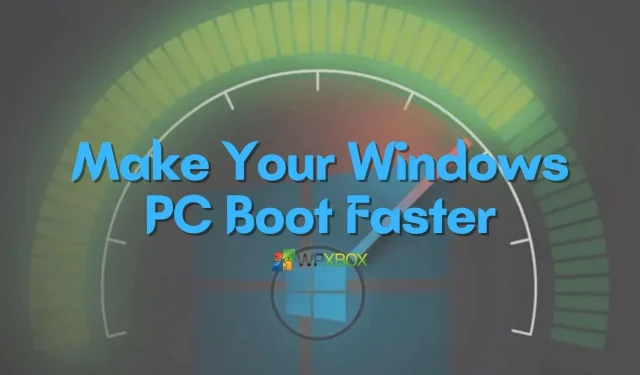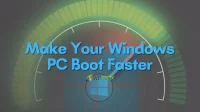Switching to a new major update can be exhilarating, but if you notice that your PC’s performance has slowed down, the excitement is gone. There are several ways to improve your PC performance and make your Windows 11/10 PC boot up faster.
Windows is constantly adding new features to its OS. They certainly make it easier for the user to use; however, they can slow down some older computers. Windows 11/10 is sleeker, more efficient, and provides several performance improvements over previous versions of Windows.
However, many users running the latest version of Windows on unsupported devices may experience performance issues such as intermittent freezes and lags. Here are some easy ways to speed up Windows 11 faster and improve speed for faster use.
Ways to speed up the boot of a PC and laptop with Windows 11/10
Windows has a lot of options that can improve the performance of your PC. Some of them are listed below:
- Restrict or remove startup applications
- Remove pre-installed malware
- Reduce or disable visual effects
- Run Disk Cleanup
- Run the performance troubleshooter
- Turn on fast startup
- Carrying out disk fragmentation
- Regularly delete unnecessary and temporary files from the disk
- Using a high performance power plan
- Disable apps running in the background
- Restart your computer regularly
- Turn off notifications
- Adding RAM or SSD
Note. When we say “boot faster”it means immediately after pressing the power button before logging into your account.
1] Limit or remove startup applications
Applications that start when Windows starts are startup applications and continue to run even if you don’t close them manually. These programs consume a lot of memory and cause Windows to start slowly.
Most startup applications are not needed to perform normal tasks in Windows, so they can be disabled in the Task Manager. This way your Windows runs faster on your PC and improves its performance. The more applications you download on your computer, the longer it will take for Windows to start up. To prevent applications from starting automatically, follow these steps:
- Open Settings (Win + I)
- Then go to Applications > Choose Startup.
- You can turn off the toggle for apps that you don’t prefer to launch automatically when you sign in to your account.
2] Remove Preinstalled Malware
Remove any extra or unnecessary software that may have been installed on your new Windows PC. Most laptops offered by OEMs come preloaded with applications that you may not need.
3] Reduce or disable visual effects
Windows has various visual effects; however, they may slow down if you have an older, less powerful computer or a bad configuration. To speed up Windows, it is recommended to remove eye effects. The process is simple; be sure to follow the instructions below.
- Use Win + S to open Search and type System Preferences.
- Open Advanced System Settings.
- Navigate to the Advanced tab and click the Settings button.
- Set the toggle to “Performance Options”in the “Performance Options”window to get the best performance.
- To save your changes, click Apply and then OK.
Once changes are made, Windows visual effects will be adjusted or disabled to ensure maximum performance.
4] Run Disk Cleanup
Windows devices create a lot of junk files every day to make it easier to perform various tasks. These include view caches, temporary files, thumbnails, delivery optimization files that take up disk space. Many of them are not required, but some are useful and very few are required,
Windows Update logs can often be huge in size, which is not required for a system restore. Several components get clogged together, causing the Windows operating system to slow down. Windows has a default Disk Cleanup tool to quickly clean up these files and you don’t have to worry about operating system security.
5] Run the Performance Troubleshooter
The performance troubleshooter will determine why this is affecting the average speed and fix it. This can help you figure out the root cause of any issues you’re having on Windows computers.
This tool is a built-in utility and is subject to change without affecting system resources or settings. Here’s how to run the utility:
- Click Start and select Run.
- In the Run dialog box, type the command −
%systemroot%\system32\msdt.exe -id MaintenanceDiagnostic - Press Enter.
- When the troubleshooting wizard is activated, click Next.
- Now click “Try to troubleshoot”as administrator.
- Restart the tool when finished.
6] Enable Fast Startup
This feature helps you start your computer faster after you turn it off. This does not affect the restart time.
- Open Run Prompt with Win+R
- Type control and press the Enter key to open the Control Panel.
- Go to Control Panel\All Control Panel Items\Power Options\System Settings.
- Click on the link Choose which power buttons
- In the settings, you will find the option to turn on fast startup.
Enable hibernation if that doesn’t work
- If you don’t see the option to enable fast startup, you need to enable sleep mode on your laptop.
- Right-click the Start button and select Command Prompt (Admin) or Windows Terminal (Admin) from the list.
- Type powercfg /hibernate on at the command prompt and press Enter.
7] Perform disk defragmentation
Because Windows stores files, they are striped across the hard drive if there is not enough space in the same sector. This increases the read/write time as the hard disk is pulling data from two places.
To solve this problem, the defragmentation feature in Windows can reorder fragmented components to work more efficiently. This reduces the read-write time. You can do it manually like below:
- Press the Windows key and type defrag.
- Then select Defrag and when the drivers appear, Optimize drives.
- To perform defragmentation Select a drive in the Optimize Drives window.
- Select Optimize.
- When done, the tool will show 100% fragmented.
Warning. Be sure to only use the defrag tool if you’re using a regular hard drive and not an SSD. If you’re using an SSD, you’ll need to use the software offered by the OEM to add allocation space so that there’s always free space and the SSD can manage itself.
8] Delete junk and temporary files from your drive regularly
The device often runs slowly due to teenage files that have accumulated on the hard drive. It is very important to clean up these files from time to time to ensure the best performance of Windows. These temporary files are Windows components that are created each time and kept on disk until the storage is full. Instead of using third-party software, you can get help from Windows’ built-in cleanup tool.
To remove unnecessary files from your hard drive, follow these steps:
- Press the Windows key + I and select the System option.
- Select “Storage”and click “Temporary Files”.
- Give it time to scan junk files.
- Then select the files you want to delete.
- Click Delete Files.
- When a confirmation pop-up appears, select Continue.
- Reboot your device.
You can also use the Windows Storage Sense feature to automatically clean up temporary folders every 30 days.
Disk Cleanup allows you to erase items in the form of temporary files – this is a rather long process. You can manually delete temporary files in the blink of an eye. To delete temporary files from your hard drive, follow these steps:
- Press the Windows + R keys, type %temp% and press Enter.
- Please select all files and folders in the window and delete them.
- Similarly, run Temp and delete unnecessary files and folders to speed up Windows.
9] Using a high-performance power management scheme
The Windows Power Plan combines system settings and hardware that optimizes power consumption. It provides the best performance and extends battery life in balanced mode. If you don’t care about battery life, you can choose a high performance power plan.
Follow the process below to achieve this on laptops.
- Find and select a power plan.
- Change your plan settings by selecting the High-performance option, or you can change your current plan.
- Next, go to Processor Power Management. Set the minimum and maximum processor states to 100%.
- To save changes and apply, restart your computer.
10] Disable apps running in the background
Windows 11 removed the setting to disable background apps, unlike Windows 10 which had a direct option under the Privacy category. Windows programs run in the background to receive notifications and updates. While some applications, such as email and messaging, need to run in the background, most other applications are useless.
Some gaming applications can slow down Windows performance because they are always in sync. It is important that you choose carefully which apps are running in the background in order to constantly drain your battery.
11] Restart your computer regularly
When you restart your PC, all unnecessary programs end. If a process hangs for too long, Windows will kill it. It is recommended that you restart your computer from time to time.
12] Update apps and drivers
Windows 11 is fast and performs well, unless certain components are outdated. If the drivers are not updated, the device will not work correctly. You should always install all available new updates whenever possible.
Check out the list of third-party apps that can help you find new drivers. You can also download them individually from the OEM website.
13] Add more RAM and switch to SSD
Using an SSD will make Windows run faster. It will start faster, run smoother, and shut down quickly. You can upgrade your Windows PC with extra RAM or a super-fast SSD. If you are using a laptop, please contact support to see if you can upgrade or change the RAM and SSD.
How to make my Windows PC lighter?
There are several ways to make your Windows PC lighter. You can try to remove unnecessary files, software, close applications on startup and reduce uncontrolled downloading from the Internet.
Does Windows 11 speed up my PC?
Yes, according to various Microsoft claims, Windows 11 does indeed make your PC faster. However, the performance of your PC is more dependent on specifications. You won’t see a significant performance difference in Windows 11 compared to older versions of the OS like Windows 10 unless the hardware meets the guidelines.
If you have already installed the latest version of Windows on your PC, follow these steps to make the most of it. These tips and tricks will help make your laptop or PC boot faster. I hope this post helps your Windows 11/10 PC be much faster and more responsive than ever before.



